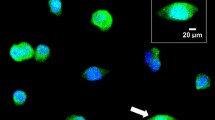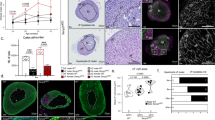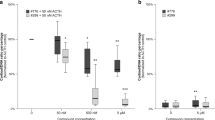Abstract
The identity of the pro-opiomelanocortin (POMC)-derived mitogen in the adrenal cortex has been historically controversial. We have used well-established in vivo models, viz., hypophysectomized (Hyp) or dexamethasone (Dex)-treated rats, to study the effect of the synthetic modified peptide N-terminal POMC (N-POMC1–28) on DNA synthesis in the adrenal cortex, as assessed by BrdU incorporation and compared with adrenocorticotropic hormone (ACTH). We evaluated the importance of disulfide bridges on proliferation by employing N-POMC1–28 without disulfide bridges and with methionines replacing cysteines. Acute administration of synthetic modified N-POMC1–28 distinctly increased DNA synthesis in the zona glomerulosa and zona fasciculata, but not in the zona reticularis in Hyp rats, whereas in Dex-treated rats, this peptide was effective in all adrenal zones. ACTH administration led to an increase of BrdU-positive cells in all adrenal zones irrespective of the depletion of Hyp or Dex-POMC peptides. The use of the ACTH antagonist, ACTH7–38, confirmed the direct participation of ACTH in proliferation. Two different approaches to measure apoptosis revealed that both peptides similarly exerted a protective effect on all adrenocortical zones, blocking the apoptotic cell death induced by hypophysectomy. Thus, ACTH1–39 and N-POMC1–28 have similar actions suggesting that the disulfide bridges are important but not essential. Both peptides seem to be important factors determining adrenocortical cell survival throughout the adrenal cortex, reinforcing the idea that each zone can be renewed from within itself.










Similar content being viewed by others
References
Baccaro RB, Mendonca PO, Torres TE, Lotfi CF (2007) Immunohistochemical Jun/Fos protein localization and DNA synthesis in rat adrenal cortex after treatment with ACTH or FGF2. Cell Tissue Res 328:7–18
Bennett HP, Seidah NG, Benjannet S, Solomon S, Chretien M (1986) Reinvestigation of the disulfide bridge arrangement in human pro-opiomelanocortin N-terminal segment (hNT 1–76). Int J Pept Protein Res 27:306–313
Bicknell AB (2003) Identification of a serine protease involved with the regulation of adrenal growth. Ann N Y Acad Sci 994:118–122
Bicknell AB, Lomthaisong K, Woods RJ, Hutchinson EG, Bennett HP, Gladwell RT, Lowry PJ (2001) Characterization of a serine protease that cleaves pro-gamma-melanotropin at the adrenal to stimulate growth. Cell 105:903–912
Bland ML, Desclozeaux M, Ingraham HA (2003) Tissue growth and remodeling of the embryonic and adult adrenal gland. Ann N Y Acad Sci 995:59–72
Bransome ED Jr (1968) Regulation of adrenal growth. Differences in the effects of ACTH in normal and dexamethasone-suppressed guinea pigs. Endocrinology 83:956–964
Carsia RV, Macdonald GJ, Gibney JA, Tilly KI, Tilly JL (1996) Apoptotic cell death in the rat adrenal gland: an in vivo and in vitro investigation. Cell Tissue Res 283:247–254
Carsia RV, Nagele RG, Morita Y, Tilly KI, Tilly JL (1998) Models to elucidate the regulation of adrenal cell death. Endocr Res 24:899–908
Chester Jones I (1957) The adrenal cortex. Cambridge University Press, Cambridge
Coll AP, Fassnacht M, Klammer S, Hahner S, Schulte DM (2006) Peripheral administration of the N-terminal pro-opiomelanocortin fragment 1–28 to Pomc-/- mice reduces food intake and weight but does not affect adrenal growth or corticosterone production. J Endocrinol 190:515–525
Dallman MF (1984) Control of adrenocortical growth in vivo. Endocr Res 10:213–242
Denef C, Roudbaraki M, Van Bael A (2001) Growth and differentiation factors derived from the N-terminal domain of pro-opiomelanocortin. Clin Exp Pharmacol Physiol 28:239–243
Estivariz FE, Iturriza F, McLean C, Hope J, Lowry PJ (1982) Stimulation of adrenal mitogenesis by N-terminal proopiocortin peptides. Nature 297:419–422
Estivariz FE, Carino M, Lowry PJ, Jackson S (1988) Further evidence that N-terminal pro-opiomelanocortin peptides are involved in adrenal mitogenesis. J Endocrinol 116:201–206
Fassnacht M, Hahner S, Hansen IA, Kreutzberger T, Zink M, Adermann K, Jakob F, Troppmair J, Allolio B (2003) N-terminal proopiomelanocortin acts as a mitogen in adrenocortical tumor cells and decreases adrenal steroidogenesis. J Clin Endocr Metab 88:2171–2179
Gavrieli Y, Sherman Y, Ben-Sasson SA (1992) Identification of programmed cell death in situ via specific labeling of nuclear DNA fragmentation. J Cell Biol 119:493–501
Hornsby PJ (1984) Regulation of adrenocortical cell proliferation in culture. Endocr Res 10:259–281
Karpac J, Ostwald D, Bui S, Hunnewell P, Shankar M, Hochgeschwender U (2005) Development, maintenance, and function of the adrenal gland in early postnatal proopiomelanocortin-null mutant mice. Endocrinology 146:2555–2562
Loh YP, Maldonado A, Zhang C, Tam WH, Cawley N (2002) Mechanism of sorting proopiomelanocortin and proenkephalin to the regulated secretory pathway of neuroendocrine cells. Ann N Y Acad Sci 971:416–425
Lowry PJ, Silas L, McLean C, Linton EA, Estivariz FE (1983) Pro-gamma-melanocyte-stimulating hormone cleavage in adrenal gland undergoing compensatory growth. Nature 306:70–73
Malendowicz LK, Nussdorfer GG, Markowska A, Nowak KW (1992) Analysis of the preventive action of ACTH on dexamethasone-induced adrenocortical atrophy in the rat. Cytobios 71:191–199
Malendowicz LK, Rebuffat P, Nussdorfer GG, Nowak KW (1998) Corticotropin-inhibiting peptide enhances aldosterone secretion by dispersed rat zona glomerulosa cells. J Steroid Biochem Mol Biol 67:149–152
Mitani F, Suzuki H, Hata J, Ogishima T, Shimada H, Ishimura Y (1994) A novel cell layer without corticosteroid-synthesizing enzymes in rat adrenal cortex: histochemical detection and possible physiological role. Endocrinology 135:431–438
McEwan PE, Vinson GP, Kenyon CJ (1999) Control of adrenal cell proliferation by AT1 receptors in response to angiotensin II and low-sodium diet. Am J Physiol 276:E303–E309
McNeill H, Whitworth E, Vinson GP, Hinson JP (2005) Distribution of extracellular signal-regulated protein kinases 1 and 2 in the rat adrenal and their activation by angiotensin II. J Endocrinol 187:149–157
Morley SD, Viard I, Chung BC, Ikeda Y, Parker KL, Mullins JJ (1996) Variegated expression of a mouse steroid 21-hydroxylase/beta-galactosidase transgene suggests centripetal migration of adrenocortical cells. Mol Endocrinol 10:585–598
New MI (1998) Diagnosis and management of congenital adrenal hyperplasia. Annu Rev Med 49:311–328
Payet N, Lehoux JG, Isler H (1980) Effect of ACTH on the proliferative and secretory activities of the adrenal glomerulosa. Acta Endocrinol (Copenh) 93:365–374
Pepper DJ, Bicknell AB (2009) The stimulation of mitogenic signaling pathways by N-POMC peptides. Mol Cell Endocrinol 300:77–82
Pignatelli D, Ferreira J, Vendeira P, Magalhaes MC, Vinson GP (2002) Proliferation of capsular stem cells induced by ACTH in the rat adrenal cortex. Endocr Res 28:683–691
Rao AJ, Long JA, Ramachandran J (1978) Effects of antiserum to adrenocorticotropin on adrenal growth and function. Endocrinology 102:371–378
Seger MA, Bennett HP (1986) Structure and bioactivity of the amino-terminal fragment of pro-opiomelanocortin. J Steroid Biochem 25:703–710
Thomas M, Keramidas M, Monchaux E, Feige JJ (2003) Role of adrenocorticotropic hormone in the development and maintenance of the adrenal cortical vasculature. Microsc Res Tech 61:247–251
Tilly JL, Hsueh AJ (1993) Microscale autoradiographic method for the qualitative and quantitative analysis of apoptotic DNA fragmentation. J Cell Physiol 154:519–526
Torres TE, Lotfi CF (2007) Distribution of cells expressing Jun and Fos proteins and synthesizing DNA in the adrenal cortex of hypophysectomized rats: regulation by ACTH and FGF2. Cell Tissue Res 329:443–455
Vinson GP (2003) Adrenocortical zonation and ACTH. Microsc Res Tech 61:227–239
Vinson GP (2004) Glomerulosa function and aldosterone synthesis in the rat. Mol Cell Endocrinol 217:59–65
Waynforth H, Flecknell P (1992) Experimental and surgical technique in the rat. Academic Press, London
Wright NA (1971) Variation in tritiated thymidine uptake during DNA synthesis in the adrenal cortex. Histochemie 28:99–102
Wyllie AH, Kerr JF, Macaskill IA, Currie AR (1973) Adrenocortical cell deletion: the role of ACTH. J Pathol 111:85–94
Zajicek G, Ariel I, Arber N (1986) The streaming adrenal cortex: direct evidence of centripetal migration of adrenocytes by estimation of cell turnover rate. J Endocrinol 111:477–482
Acknowledgements
We are grateful to Dr. Maria Aparecida Juliano from the Department of Biochemistry and Biophysics of the Federal University of São Paulo (UNIFESP) for the synthesis of N-POMC peptides and to Dr. Marina Baquerizo Martinez for technical assistance with measurements of the circulating plasma ACTH.
Author information
Authors and Affiliations
Corresponding author
Additional information
The authors declare no conflicts of interest to prejudice the impartiality of the research reported.
T.E.P.T. and P.O.R.M. are recipients of scholarships from the Fundação de Amparo à Pesquisa do Estado de São Paulo (FAPESP, Foundation for the Support of Research in the State of São Paulo); C.F.P.L. received funding from FAPESP, from the Conselho Nacional de Desenvolvimento Científico e Tecnológico (CNPq, The National Council for Scientific and Technological Development), and from the Pró-Reitoria de Pesquisa da Universidade de São Paulo (University of São Paulo Dean’s Office for Research Projects).
Rights and permissions
About this article
Cite this article
Torres, T.E.P., de Mendonça, P.O.R. & Lotfi, C.F.P. Synthetic modified N-POMC1–28 controls in vivo proliferation and blocks apoptosis in rat adrenal cortex. Cell Tissue Res 341, 239–250 (2010). https://doi.org/10.1007/s00441-010-0998-0
Received:
Accepted:
Published:
Issue Date:
DOI: https://doi.org/10.1007/s00441-010-0998-0




